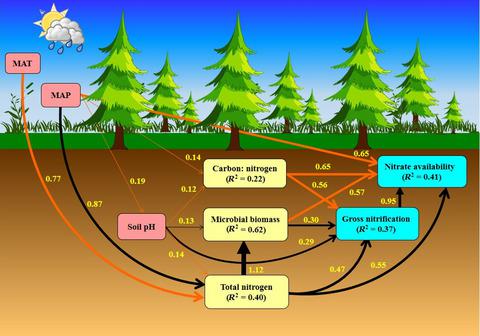当前位置:
X-MOL 学术
›
Glob. Change Biol.
›
论文详情
Our official English website, www.x-mol.net, welcomes your
feedback! (Note: you will need to create a separate account there.)
Global gross nitrification rates are dominantly driven by soil carbon-to-nitrogen stoichiometry and total nitrogen
Global Change Biology ( IF 10.8 ) Pub Date : 2021-09-12 , DOI: 10.1111/gcb.15883 Ahmed S Elrys 1, 2 , Jing Wang 3 , Mohamed A S Metwally 2 , Yi Cheng 1, 4, 5 , Jin-Bo Zhang 1 , Zu-Cong Cai 1 , Scott X Chang 6 , Christoph Müller 7, 8
Global Change Biology ( IF 10.8 ) Pub Date : 2021-09-12 , DOI: 10.1111/gcb.15883 Ahmed S Elrys 1, 2 , Jing Wang 3 , Mohamed A S Metwally 2 , Yi Cheng 1, 4, 5 , Jin-Bo Zhang 1 , Zu-Cong Cai 1 , Scott X Chang 6 , Christoph Müller 7, 8
Affiliation

|
Soil gross nitrification (GN) is a critical process in the global nitrogen (N) cycle that results in the formation of nitrate through microbial oxidation of ammonium or organic N, and can both increase N availability to plants and nitrous oxide emissions. Soil GN is thought to be mainly controlled by soil characteristics and the climate, but a comprehensive analysis taking into account the climate, soil characteristics, including microbial characteristics, and their interactions to better understand the direct and indirect controlling factors of GN rates globally is lacking. Using a global meta-analysis based on 901 observations from 330 15N-labeled studies, we show that GN differs significantly among ecosystem types, with the highest rates found in croplands, in association with higher pH which stimulates nitrifying bacteria activities. Autotrophic and heterotrophic nitrifications contribute 63% and 37%, respectively, to global GN. Soil GN increases significantly with soil total N, microbial biomass, and soil pH, but decreases significantly with soil carbon (C) to N ratio (C:N). Structural equation modeling suggested that GN is mainly controlled by C:N and soil total N. Microbial biomass and pH are also important factors controlling GN and their effects are similar. Precipitation and temperature affect GN by altering C:N and/or soil total N. Soil total N and temperature drive heterotrophic nitrification, whereas C:N and pH drive autotrophic nitrification. Moreover, GN is positively related to nitrous oxide and carbon dioxide emissions. This synthesis suggests that changes in soil C:N, soil total N, microbial population size, and/or soil pH due to anthropogenic activities may influence GN, which will affect nitrate accumulation and gaseous emissions of soils under global climate and land-use changes.
中文翻译:

全球总硝化率主要由土壤碳氮化学计量和总氮驱动
土壤总硝化 (GN) 是全球氮 (N) 循环中的一个关键过程,它通过铵或有机 N 的微生物氧化形成硝酸盐,并且可以增加植物的 N 可用性和一氧化二氮排放。土壤GN被认为主要受土壤特征和气候控制,但缺乏综合分析考虑气候、土壤特征(包括微生物特征)及其相互作用以更好地了解全球GN发生率的直接和间接控制因素. 使用基于 330 15 的901 个观察结果的全球荟萃分析N 标记的研究表明,GN 在生态系统类型之间存在显着差异,在农田中发现的比率最高,这与刺激硝化细菌活动的较高 pH 值有关。自养和异养硝化作用分别对全球 GN 贡献 63% 和 37%。土壤 GN 随土壤总氮、微生物生物量和土壤 pH 值显着增加,但随土壤碳 (C) 与 N 比 (C:N) 显着降低。结构方程模型表明 GN 主要受 C:N 和土壤总 N 控制。微生物生物量和 pH 也是控制 GN 的重要因素,它们的作用相似。降水和温度通过改变 C:N 和/或土壤总 N 来影响 GN。土壤总 N 和温度驱动异养硝化,而 C:N 和 pH 驱动自养硝化。而且,GN 与一氧化二氮和二氧化碳排放量呈正相关。这种综合表明,由于人为活动引起的土壤 C:N、土壤总氮、微生物种群大小和/或土壤 pH 值的变化可能会影响 GN,这将影响全球气候和土地利用变化下土壤的硝酸盐积累和气体排放.
更新日期:2021-11-12
中文翻译:

全球总硝化率主要由土壤碳氮化学计量和总氮驱动
土壤总硝化 (GN) 是全球氮 (N) 循环中的一个关键过程,它通过铵或有机 N 的微生物氧化形成硝酸盐,并且可以增加植物的 N 可用性和一氧化二氮排放。土壤GN被认为主要受土壤特征和气候控制,但缺乏综合分析考虑气候、土壤特征(包括微生物特征)及其相互作用以更好地了解全球GN发生率的直接和间接控制因素. 使用基于 330 15 的901 个观察结果的全球荟萃分析N 标记的研究表明,GN 在生态系统类型之间存在显着差异,在农田中发现的比率最高,这与刺激硝化细菌活动的较高 pH 值有关。自养和异养硝化作用分别对全球 GN 贡献 63% 和 37%。土壤 GN 随土壤总氮、微生物生物量和土壤 pH 值显着增加,但随土壤碳 (C) 与 N 比 (C:N) 显着降低。结构方程模型表明 GN 主要受 C:N 和土壤总 N 控制。微生物生物量和 pH 也是控制 GN 的重要因素,它们的作用相似。降水和温度通过改变 C:N 和/或土壤总 N 来影响 GN。土壤总 N 和温度驱动异养硝化,而 C:N 和 pH 驱动自养硝化。而且,GN 与一氧化二氮和二氧化碳排放量呈正相关。这种综合表明,由于人为活动引起的土壤 C:N、土壤总氮、微生物种群大小和/或土壤 pH 值的变化可能会影响 GN,这将影响全球气候和土地利用变化下土壤的硝酸盐积累和气体排放.











































 京公网安备 11010802027423号
京公网安备 11010802027423号